Emmanouil Benetos
QMUL
RUMAA: Repeat-Aware Unified Music Audio Analysis for Score-Performance Alignment, Transcription, and Mistake Detection
Jul 16, 2025Abstract:This study introduces RUMAA, a transformer-based framework for music performance analysis that unifies score-to-performance alignment, score-informed transcription, and mistake detection in a near end-to-end manner. Unlike prior methods addressing these tasks separately, RUMAA integrates them using pre-trained score and audio encoders and a novel tri-stream decoder capturing task interdependencies through proxy tasks. It aligns human-readable MusicXML scores with repeat symbols to full-length performance audio, overcoming traditional MIDI-based methods that rely on manually unfolded score-MIDI data with pre-specified repeat structures. RUMAA matches state-of-the-art alignment methods on non-repeated scores and outperforms them on scores with repeats in a public piano music dataset, while also delivering promising transcription and mistake detection results.
Refining music sample identification with a self-supervised graph neural network
Jun 17, 2025Abstract:Automatic sample identification (ASID), the detection and identification of portions of audio recordings that have been reused in new musical works, is an essential but challenging task in the field of audio query-based retrieval. While a related task, audio fingerprinting, has made significant progress in accurately retrieving musical content under "real world" (noisy, reverberant) conditions, ASID systems struggle to identify samples that have undergone musical modifications. Thus, a system robust to common music production transformations such as time-stretching, pitch-shifting, effects processing, and underlying or overlaying music is an important open challenge. In this work, we propose a lightweight and scalable encoding architecture employing a Graph Neural Network within a contrastive learning framework. Our model uses only 9% of the trainable parameters compared to the current state-of-the-art system while achieving comparable performance, reaching a mean average precision (mAP) of 44.2%. To enhance retrieval quality, we introduce a two-stage approach consisting of an initial coarse similarity search for candidate selection, followed by a cross-attention classifier that rejects irrelevant matches and refines the ranking of retrieved candidates - an essential capability absent in prior models. In addition, because queries in real-world applications are often short in duration, we benchmark our system for short queries using new fine-grained annotations for the Sample100 dataset, which we publish as part of this work.
CMI-Bench: A Comprehensive Benchmark for Evaluating Music Instruction Following
Jun 14, 2025Abstract:Recent advances in audio-text large language models (LLMs) have opened new possibilities for music understanding and generation. However, existing benchmarks are limited in scope, often relying on simplified tasks or multi-choice evaluations that fail to reflect the complexity of real-world music analysis. We reinterpret a broad range of traditional MIR annotations as instruction-following formats and introduce CMI-Bench, a comprehensive music instruction following benchmark designed to evaluate audio-text LLMs on a diverse set of music information retrieval (MIR) tasks. These include genre classification, emotion regression, emotion tagging, instrument classification, pitch estimation, key detection, lyrics transcription, melody extraction, vocal technique recognition, instrument performance technique detection, music tagging, music captioning, and (down)beat tracking: reflecting core challenges in MIR research. Unlike previous benchmarks, CMI-Bench adopts standardized evaluation metrics consistent with previous state-of-the-art MIR models, ensuring direct comparability with supervised approaches. We provide an evaluation toolkit supporting all open-source audio-textual LLMs, including LTU, Qwen-audio, SALMONN, MusiLingo, etc. Experiment results reveal significant performance gaps between LLMs and supervised models, along with their culture, chronological and gender bias, highlighting the potential and limitations of current models in addressing MIR tasks. CMI-Bench establishes a unified foundation for evaluating music instruction following, driving progress in music-aware LLMs.
MMAR: A Challenging Benchmark for Deep Reasoning in Speech, Audio, Music, and Their Mix
May 19, 2025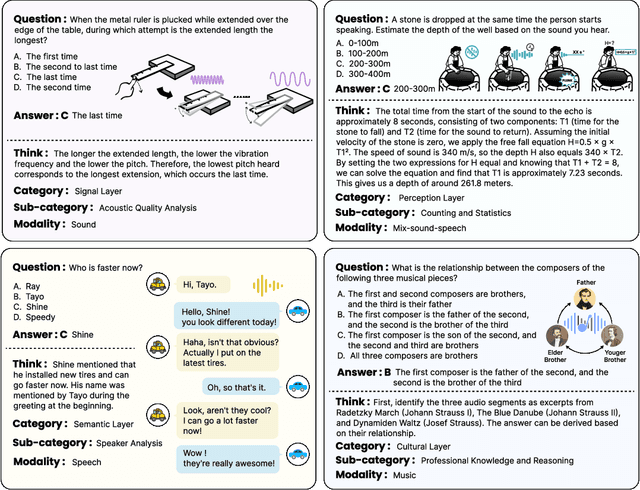
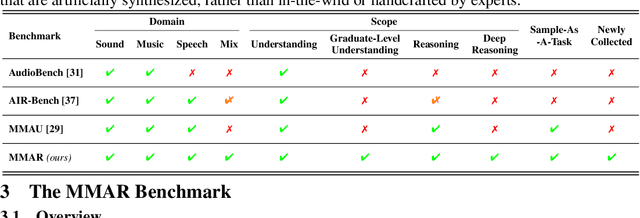
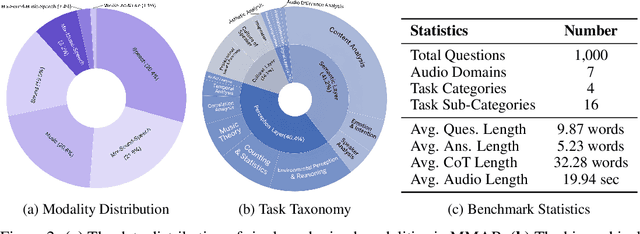
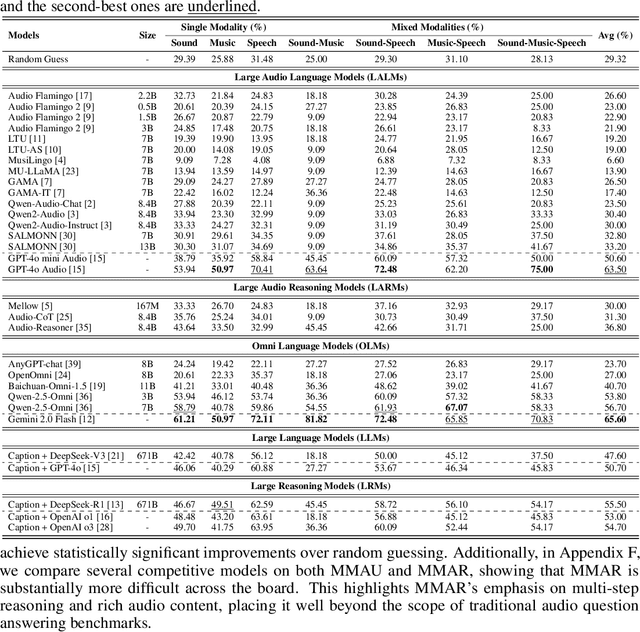
Abstract:We introduce MMAR, a new benchmark designed to evaluate the deep reasoning capabilities of Audio-Language Models (ALMs) across massive multi-disciplinary tasks. MMAR comprises 1,000 meticulously curated audio-question-answer triplets, collected from real-world internet videos and refined through iterative error corrections and quality checks to ensure high quality. Unlike existing benchmarks that are limited to specific domains of sound, music, or speech, MMAR extends them to a broad spectrum of real-world audio scenarios, including mixed-modality combinations of sound, music, and speech. Each question in MMAR is hierarchically categorized across four reasoning layers: Signal, Perception, Semantic, and Cultural, with additional sub-categories within each layer to reflect task diversity and complexity. To further foster research in this area, we annotate every question with a Chain-of-Thought (CoT) rationale to promote future advancements in audio reasoning. Each item in the benchmark demands multi-step deep reasoning beyond surface-level understanding. Moreover, a part of the questions requires graduate-level perceptual and domain-specific knowledge, elevating the benchmark's difficulty and depth. We evaluate MMAR using a broad set of models, including Large Audio-Language Models (LALMs), Large Audio Reasoning Models (LARMs), Omni Language Models (OLMs), Large Language Models (LLMs), and Large Reasoning Models (LRMs), with audio caption inputs. The performance of these models on MMAR highlights the benchmark's challenging nature, and our analysis further reveals critical limitations of understanding and reasoning capabilities among current models. We hope MMAR will serve as a catalyst for future advances in this important but little-explored area.
Learning Music Audio Representations With Limited Data
May 09, 2025Abstract:Large deep-learning models for music, including those focused on learning general-purpose music audio representations, are often assumed to require substantial training data to achieve high performance. If true, this would pose challenges in scenarios where audio data or annotations are scarce, such as for underrepresented music traditions, non-popular genres, and personalized music creation and listening. Understanding how these models behave in limited-data scenarios could be crucial for developing techniques to tackle them. In this work, we investigate the behavior of several music audio representation models under limited-data learning regimes. We consider music models with various architectures, training paradigms, and input durations, and train them on data collections ranging from 5 to 8,000 minutes long. We evaluate the learned representations on various music information retrieval tasks and analyze their robustness to noise. We show that, under certain conditions, representations from limited-data and even random models perform comparably to ones from large-dataset models, though handcrafted features outperform all learned representations in some tasks.
Towards a Unified Representation Evaluation Framework Beyond Downstream Tasks
May 09, 2025Abstract:Downstream probing has been the dominant method for evaluating model representations, an important process given the increasing prominence of self-supervised learning and foundation models. However, downstream probing primarily assesses the availability of task-relevant information in the model's latent space, overlooking attributes such as equivariance, invariance, and disentanglement, which contribute to the interpretability, adaptability, and utility of representations in real-world applications. While some attempts have been made to measure these qualities in representations, no unified evaluation framework with modular, generalizable, and interpretable metrics exists. In this paper, we argue for the importance of representation evaluation beyond downstream probing. We introduce a standardized protocol to quantify informativeness, equivariance, invariance, and disentanglement of factors of variation in model representations. We use it to evaluate representations from a variety of models in the image and speech domains using different architectures and pretraining approaches on identified controllable factors of variation. We find that representations from models with similar downstream performance can behave substantially differently with regard to these attributes. This hints that the respective mechanisms underlying their downstream performance are functionally different, prompting new research directions to understand and improve representations.
From Aesthetics to Human Preferences: Comparative Perspectives of Evaluating Text-to-Music Systems
Apr 30, 2025Abstract:Evaluating generative models remains a fundamental challenge, particularly when the goal is to reflect human preferences. In this paper, we use music generation as a case study to investigate the gap between automatic evaluation metrics and human preferences. We conduct comparative experiments across five state-of-the-art music generation approaches, assessing both perceptual quality and distributional similarity to human-composed music. Specifically, we evaluate synthesis music from various perceptual dimensions and examine reference-based metrics such as Mauve Audio Divergence (MAD) and Kernel Audio Distance (KAD). Our findings reveal significant inconsistencies across the different metrics, highlighting the limitation of the current evaluation practice. To support further research, we release a benchmark dataset comprising samples from multiple models. This study provides a broader perspective on the alignment of human preference in generative modeling, advocating for more human-centered evaluation strategies across domains.
YuE: Scaling Open Foundation Models for Long-Form Music Generation
Mar 11, 2025Abstract:We tackle the task of long-form music generation--particularly the challenging \textbf{lyrics-to-song} problem--by introducing YuE, a family of open foundation models based on the LLaMA2 architecture. Specifically, YuE scales to trillions of tokens and generates up to five minutes of music while maintaining lyrical alignment, coherent musical structure, and engaging vocal melodies with appropriate accompaniment. It achieves this through (1) track-decoupled next-token prediction to overcome dense mixture signals, (2) structural progressive conditioning for long-context lyrical alignment, and (3) a multitask, multiphase pre-training recipe to converge and generalize. In addition, we redesign the in-context learning technique for music generation, enabling versatile style transfer (e.g., converting Japanese city pop into an English rap while preserving the original accompaniment) and bidirectional generation. Through extensive evaluation, we demonstrate that YuE matches or even surpasses some of the proprietary systems in musicality and vocal agility. In addition, fine-tuning YuE enables additional controls and enhanced support for tail languages. Furthermore, beyond generation, we show that YuE's learned representations can perform well on music understanding tasks, where the results of YuE match or exceed state-of-the-art methods on the MARBLE benchmark. Keywords: lyrics2song, song generation, long-form, foundation model, music generation
Audio-FLAN: A Preliminary Release
Feb 23, 2025Abstract:Recent advancements in audio tokenization have significantly enhanced the integration of audio capabilities into large language models (LLMs). However, audio understanding and generation are often treated as distinct tasks, hindering the development of truly unified audio-language models. While instruction tuning has demonstrated remarkable success in improving generalization and zero-shot learning across text and vision, its application to audio remains largely unexplored. A major obstacle is the lack of comprehensive datasets that unify audio understanding and generation. To address this, we introduce Audio-FLAN, a large-scale instruction-tuning dataset covering 80 diverse tasks across speech, music, and sound domains, with over 100 million instances. Audio-FLAN lays the foundation for unified audio-language models that can seamlessly handle both understanding (e.g., transcription, comprehension) and generation (e.g., speech, music, sound) tasks across a wide range of audio domains in a zero-shot manner. The Audio-FLAN dataset is available on HuggingFace and GitHub and will be continuously updated.
LHGNN: Local-Higher Order Graph Neural Networks For Audio Classification and Tagging
Jan 07, 2025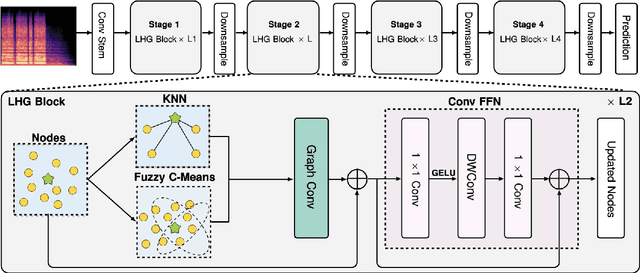
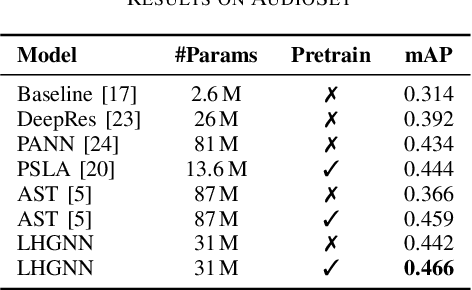

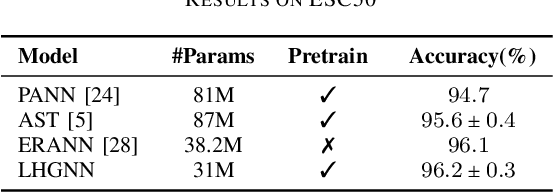
Abstract:Transformers have set new benchmarks in audio processing tasks, leveraging self-attention mechanisms to capture complex patterns and dependencies within audio data. However, their focus on pairwise interactions limits their ability to process the higher-order relations essential for identifying distinct audio objects. To address this limitation, this work introduces the Local- Higher Order Graph Neural Network (LHGNN), a graph based model that enhances feature understanding by integrating local neighbourhood information with higher-order data from Fuzzy C-Means clusters, thereby capturing a broader spectrum of audio relationships. Evaluation of the model on three publicly available audio datasets shows that it outperforms Transformer-based models across all benchmarks while operating with substantially fewer parameters. Moreover, LHGNN demonstrates a distinct advantage in scenarios lacking ImageNet pretraining, establishing its effectiveness and efficiency in environments where extensive pretraining data is unavailable.
 Add to Chrome
Add to Chrome Add to Firefox
Add to Firefox Add to Edge
Add to Edge